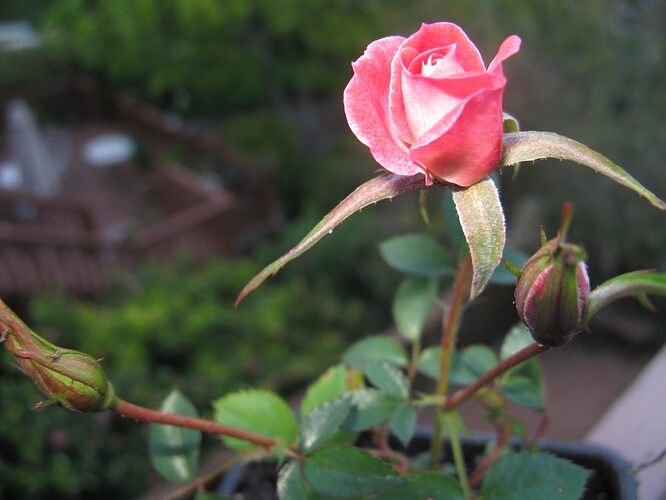- Heavily cross my key female Oso Easy Italian Ice with my key male: Rainbow’s End. That cross yields a wide range of offspring so I don’t worry about redundancy.
- I do very little labeling. I enable that by having four plants of Oso Easy Italian Ice and allocate each to a particular male.In addition to Rainbow’s End, I use the following, which are fine cultivars in their own right and are consistent with my breeding goal: compact, healthy, HT-form, and which produce pollen near constantly, so I always have a fresh supply: Sunrosa (Red), my seedling #196 and an unnamed PorLaMar pot red. This year, I’m also trying Dragonfruit Sunblaze as female and male, Chuckles as female, and Gaye Hammond as female.
2a. If I don’t have enough of a cultivar’s pollen for a given plant, I use a 2nd choice. I pick something different in color (e.g., a yellow rather than red), so when the seedlings emerge, I can make a decent guess as to which of the two pollens was the daddy. That allows me to not label even in that circumstance.
I leave unnamed the seedlings I graduate to a larger pot –e.g., just retaining its number, e.g., 2417, which lets me know it’s the 17th seedling I graduated in 2024. On average, the first seedlings to graduate are early to bloom, have HT bloom of at least a dozen petals, little or no disease (under no-spray conditions), and good vigor.
If, as I walk the seedlings, an appropriate name for a cultivar pops to mind, I write that on the large plastic stake/label mentioned below in pencil, which doesn’t fade. As of today. May 31, I graduated 41 and have since culled 28 of those. I’ve re-graduated three to one-gallons. I’ve named a few. Hot is yellow and orange, Blush is, yes, blushing white, *Kiss Me You Fool" is hot pink, “Fill Me Up, Buttercup” is yellow, and Stunning Redhead is, of course, a beautiful red.
All have HT form–I toss almost all with nondescript form–I believe that if a cultivar doesn’t have HT form, it has no important advantage over the easy-to-care-for geranium. I have a few excellent geraniums to remind me of that benchmark.
-
Each year, I start with about 2,000 seeds, planted in deep flats. My germination rate averages 18%, so I scatter the seeds (they’re mainly miniatures) about every 3/4 inch but don’t bother placing them individually. I just slowly drop a handful so they’re around 3/4 inch apart and then use a pencil to nudge over those that are too close to another seed. If decent-growing seedlings grow too close to each other, I lift one with my fingers or a teaspoon and replant it in a bare space or a 4" pot.
-
Because I live in Oakland CA, which gets little blackspot, I try to induce blackspot by rubbing blackspotted leaves on my better seedings and spraying them with water that has blackspotted leaves in it. I do that in early evening so the leaves stay wet for the needed 7 hours. I keep the seedlings very close together to increase humidity.
-
I cull ruthlessly, not because I don’t have space but because if a seedling isn’t close to disease-free, at least 12 petals with hybrid tea form and good vigor right away, it’s statistically not worth my time and effort. By the end of the first bloom cycle, I’m down to about a dozen seedlings. Any that look quite good, get transplanted into a 4 or 5" deep plastic pot and get a 3|" wide white plastic stake that I’ve snipped off (with my pruning shears) the top 2" of the stake. I stick it in the soil and make occasional notes on it in pencil as I walk my seedlings. If one is looking really good, I put a gold toothpick in the soil next to the stake. If a seedling is looking like it’s likely a goner but not definitely, I put a gray toothpick next to it.
As mentioned, as of May 31, 2024, I’m down to 13 seedlings and have re-graduated three to one-gallons.
- By mid-November, I usually have 2 or 3 that I believe are worthy of testing by the rose companies that are testing my previous years’ roses. I send them pix, an honest report on its pros and cons, and ask if they’d like me to send wood. I’m a writer so I give each a working name such as those I mentioned above. I also want to use “I Love You.”
Here are some pix of my 2024s




